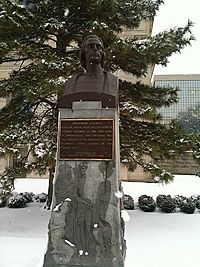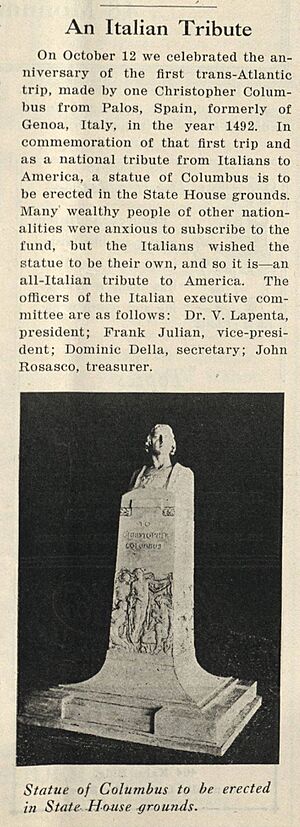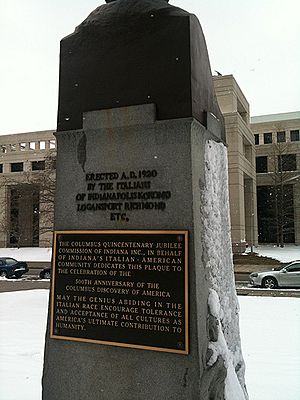Christopher Columbus (Vittori) facts for kids
Quick facts for kids Christopher Columbus |
|
|---|---|
 |
|
| Artist | Enrico Vittori |
| Year | 1920, renovated 1955 |
| Type | Bronze bust on granite pedestal and granite base |
| Dimensions | 344 cm × 200 cm × 190 cm (135.5 in × 80 in × 76 in) |
| Location | Indiana Statehouse, Indianapolis |
| 39°46′4.85″N 86°9′47.45″W / 39.7680139°N 86.1631806°W | |
| Owner | State of Indiana Department of Administration |
The Christopher Columbus sculpture is a public artwork by Italian artist Enrico Vittori. You can find it on the grounds of the Indiana Statehouse in Indianapolis, Indiana. This sculpture was put in place in 1920. It was a gift from Italian immigrant communities living in Indiana.
Contents
What Does the Sculpture Show?
A plaque on the sculpture explains that the artist, Enrico Vittori, wanted to show "the lasting genius found in the Italian people." Vittori created a central figure of a young man, dressed in a simple, flowing cloth. This style often appeared in old Roman art. He wears a laurel wreath, which is a symbol of wisdom.
Around this central figure, Vittori placed three other figures.
- One figure represents Native Americans. This figure wears a feathered headdress and is shown kneeling.
- Behind the central figure is a person representing the Black community. This figure has "wooly" hair, which was Vittori's way of showing their race since the bronze material doesn't show skin color. This figure stands near the central man.
- Another figure represents white womanhood. This figure is also shown kneeling near the central man.
Looking Closely at the Sculpture
The top part of the sculpture is a bronze bust (head and shoulders) of the explorer Christopher Columbus. He is wearing clothes from his time, and his hair reaches his chin. He has a serious look on his face and gazes slightly to his left. The artist's name, E. VITTORI, is carved below his left shoulder.
The bust of Columbus is about 39 inches (99 cm) tall, 23 inches (58 cm) wide, and 29 inches (74 cm) deep. It sits on a granite pedestal. This pedestal is about 82 inches (208 cm) tall, 62 inches (157 cm) wide, and 58 inches (147 cm) deep. Below the pedestal is a granite base, which is about 14.5 inches (37 cm) tall, 80 inches (203 cm) wide, and 76 inches (193 cm) deep.
The granite pedestal has a plaque and carved pictures called relief carvings. The carving on the front shows the central man with the laurel crown. His left arm is raised, and his right hand is near his waist. On both sides of this man, there are three other figures, with two of them kneeling. On the right side of the pedestal, there's a carving of a seated woman with her hand on her chest and the other on a large anchor. On the left side, another seated woman rests her elbow on a globe. The pedestal widens out at the bottom to meet a two-step granite base.
History of the Sculpture
The Christopher Columbus sculpture was made by Enrico (Harry) Vittori. He was an Italian artist who lived in Indianapolis. Vittori studied art in Florence, Italy. He came to Indianapolis in 1919 to work for an airplane company.
Italian communities in Indiana gave this sculpture to the state in 1920. It is the only monument at the Indiana Statehouse that was donated by immigrants. The Italian community intended it as a tribute to America.
The sculpture stayed the same for 35 years. In 1955, the Knights of Columbus paid to clean the bronze bust. They also added new bronze letters to the back of the pedestal. The sculpture was changed again in 1992 during the Columbus Quincentenary. This event celebrated 500 years since Columbus's voyage to America. The Knights of Columbus added another plaque. This plaque includes a message about how the "genius abiding in the Italian Race" should encourage kindness and acceptance of all cultures.
Plaques and Messages
Metal letters on the back of the pedestal say:
- ERECTED A.D. 1920
- BY THE ITALIANS
- OF INDIANAPOLIS KOKOMO
- LOGANSPORT RICHMOND
- ETC.
A plaque on the front of the pedestal, added in 1956, reads:
- CHRISTOPHER COLUMBUS
- BORN IN GENOA, ITALY 1451. DISCOVERED
- AMERICA OCTOBER 12, 1492. THIS LAND
- OF OPPORTUNITY AND FREEDOM WAS
- THUS PRESERVED FOR HUMANITY BY THE
- PERENNIAL GENIUS ABIDING IN THE
- ITALIAN RACE.
- REFURBISHED BY KNIGHTS OF COLUMBUS 1956.
Another plaque on the back of the pedestal, added in 1992, says:
- THE COLUMBUS QUINCENTENARY JUBILEE
- COMMISSION OF INDIANA INC., IN BEHALF
- OF INDIANA'S ITALIAN-AMERICAN
- COMMUNITY DEDICATES THIS PLAQUE TO
- THE CELEBRATION OF THE 500TH ANNIVERSARY OF THE
- COLUMBUS DISCOVERY OF AMERICA
- MAY THE GENIUS ABIDING IN THE ITALIAN RACE ENCOURAGE TOLERANCE
- AND ACCEPTANCE OF ALL CULTURES AS
- AMERICA'S ULTIMATE CONTRIBUTION TO HUMANITY.
How the Sculpture Was Acquired
The Christopher Columbus sculpture was a gift from Italian immigrants in Indiana. Money for the sculpture was raised through a campaign led by Vincent A. LaPenta. He was a surgeon and scientist. Indiana Governor James P. Goodrich officially dedicated the sculpture on October 31, 1920. At the ceremony, LaPenta said that "Columbus can be considered humanity's greatest benefactor."
The State of Indiana, Department of Administration, now owns the sculpture.
Where It's Located
The Christopher Columbus sculpture was placed on the Indiana Statehouse lawn soon after it was finished. It has stayed in the same spot ever since. Originally, there was a suggestion to put the sculpture in one of Indianapolis's parks, with "University Square" being a possible location.
Condition of the Sculpture
The Christopher Columbus sculpture was cleaned in 1992. In 1994, experts checked its condition as part of the Save Outdoor Sculpture! project. They rated its overall condition as "good." However, they noted that the sculpture would benefit from more care. It had some metal stains, erosion, green caulking on the pedestal, and bird droppings.



